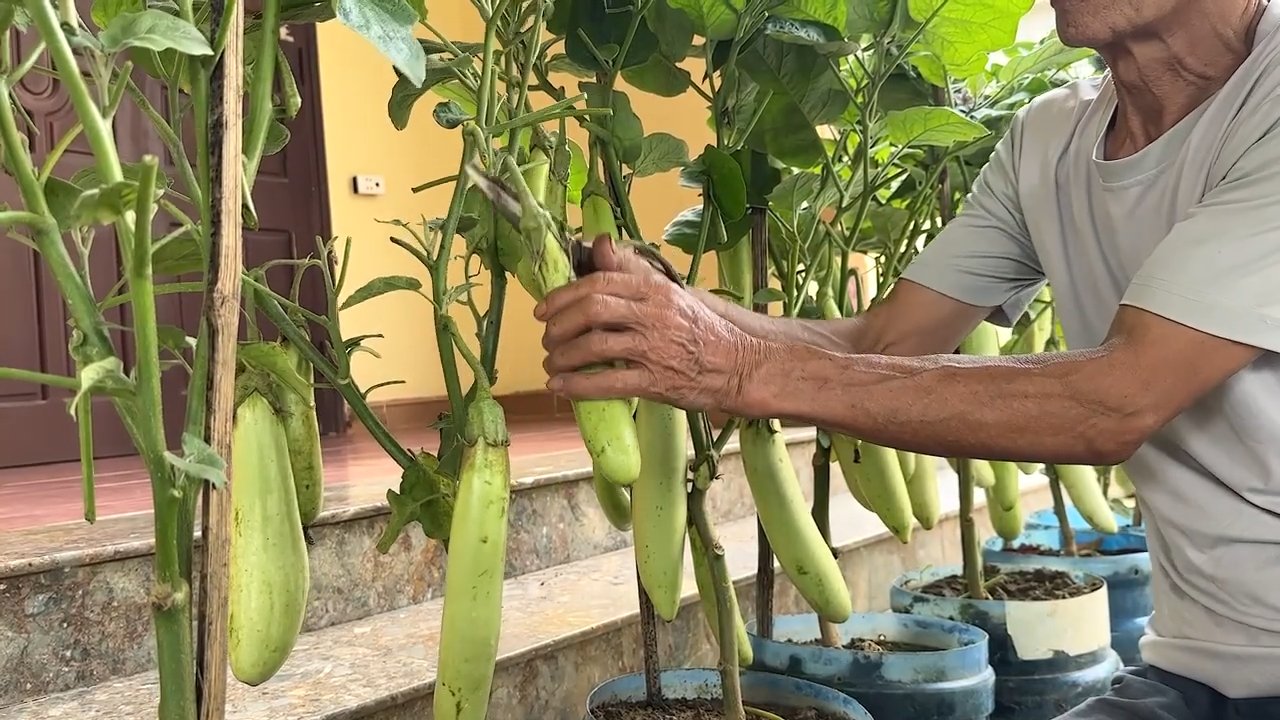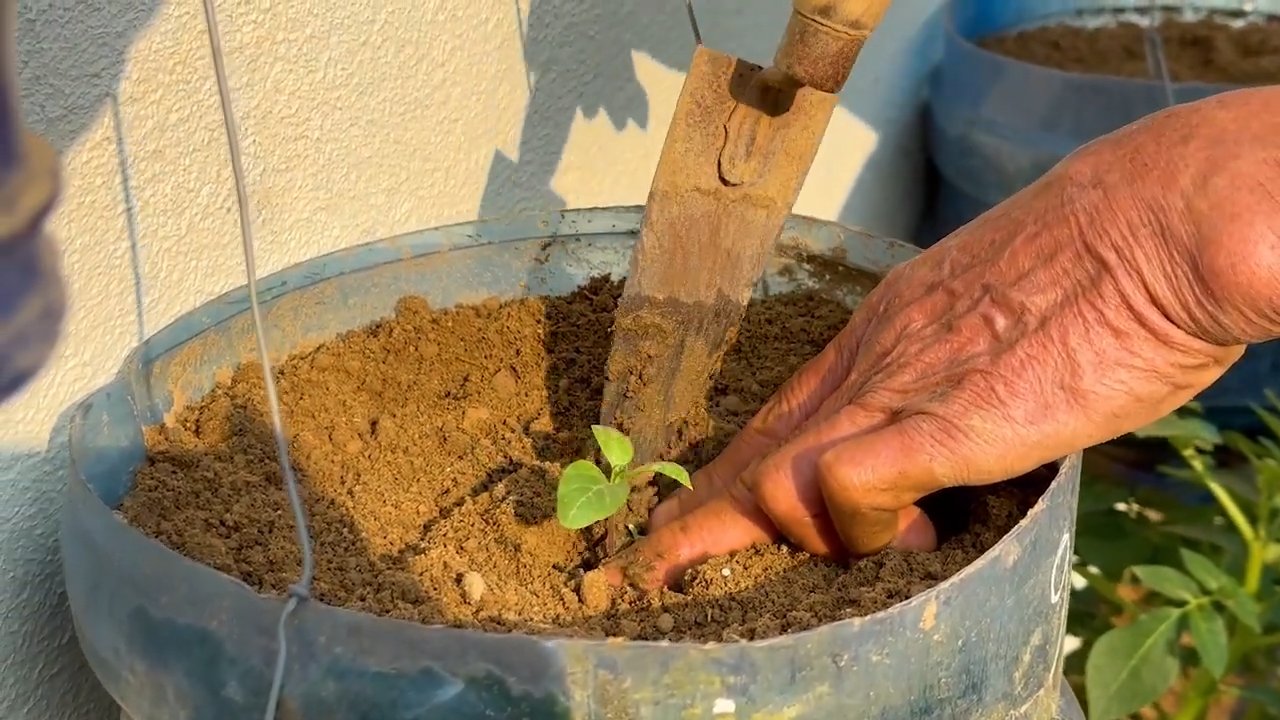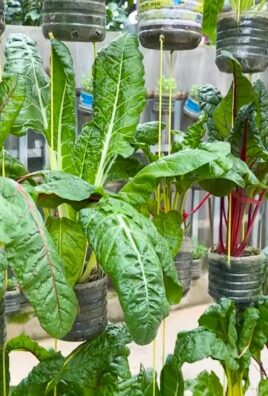Growing White Eggplants might sound like an exotic culinary adventure reserved for seasoned gardeners, but trust me, it’s a surprisingly achievable and rewarding project for anyone, even if you’re just starting out! Have you ever dreamt of strolling through your own backyard, plucking a creamy, ivory-colored eggplant straight from the vine, ready to be transformed into a delicious dish? Well, this DIY guide is your ticket to making that dream a reality.
Eggplants, in general, have a rich history, originating in Southeast Asia and gradually making their way across the globe. While the familiar deep purple variety dominates supermarket shelves, white eggplants offer a unique aesthetic appeal and a subtly different flavor profile – often described as milder and less bitter. They’ve been cultivated in various cultures for centuries, adding a touch of elegance to gardens and kitchens alike.
But why should you bother with growing white eggplants yourself? In today’s world, knowing where your food comes from and having control over its quality is more important than ever. Plus, let’s be honest, there’s a certain satisfaction that comes from nurturing a plant from seed to harvest. This DIY guide will equip you with all the essential tricks and hacks you need to successfully cultivate these beautiful and delicious vegetables, even if you have limited space or gardening experience. I’m here to help you every step of the way, from choosing the right seeds to troubleshooting common problems, so you can enjoy a bountiful harvest of homegrown white eggplants!

Weiße Auberginen selbst anbauen: Ein umfassender DIY-Leitfaden
Hallo liebe Gartenfreunde! Habt ihr Lust, etwas Besonderes in eurem Garten anzubauen? Dann lasst uns gemeinsam in die Welt der weißen Auberginen eintauchen! Diese ungewöhnlichen Schönheiten sind nicht nur ein Hingucker, sondern auch geschmacklich eine Bereicherung. Ich zeige euch, wie ihr diese delikaten Früchte erfolgreich selbst anbauen könnt. Keine Angst, es ist einfacher als ihr denkt!
Was du für den Anbau weißer Auberginen brauchst
Bevor wir loslegen, hier eine Liste der Dinge, die ihr benötigt:
* Auberginensamen (weiße Sorte): Achtet auf eine hochwertige Sorte, die für euer Klima geeignet ist.
* Anzuchterde: Diese ist nährstoffarm und ideal für die Keimung.
* Anzuchttöpfe oder -schalen: Kleine Töpfe oder Schalen mit Drainagelöchern.
* Pflanzerde: Eine nährstoffreiche Erde für das Auspflanzen.
* Große Töpfe (optional): Wenn ihr die Auberginen im Topf anbauen möchtet.
* Gartenschere: Zum Beschneiden der Pflanzen.
* Pflanzstäbe: Zur Unterstützung der wachsenden Pflanzen.
* Dünger: Ein organischer Dünger ist ideal.
* Gießkanne oder Gartenschlauch: Zum Bewässern.
* Geduld und Liebe: Das Wichtigste überhaupt!
Aussaat und Anzucht
Die Anzucht ist der erste wichtige Schritt. Hier zeige ich euch, wie ihr die Samen zum Keimen bringt:
1. Vorbereitung der Anzuchttöpfe: Füllt die Anzuchttöpfe oder -schalen mit Anzuchterde. Drückt die Erde leicht an.
2. Aussaat der Samen: Legt in jeden Topf 1-2 Samen. Bedeckt sie mit einer dünnen Schicht Erde (ca. 0,5 cm).
3. Bewässerung: Befeuchtet die Erde vorsichtig mit einer Sprühflasche oder einer Gießkanne mit feinem Strahl. Die Erde sollte feucht, aber nicht nass sein.
4. Standort: Stellt die Töpfe an einen warmen, hellen Ort. Eine Temperatur von 22-25°C ist ideal für die Keimung. Ein Mini-Gewächshaus oder eine durchsichtige Plastikabdeckung kann helfen, die Feuchtigkeit zu halten.
5. Keimung: Die Samen keimen in der Regel innerhalb von 1-2 Wochen. Achtet darauf, dass die Erde während dieser Zeit feucht bleibt.
6. Pikieren: Sobald die Sämlinge ihre ersten richtigen Blätter (nach den Keimblättern) entwickelt haben, könnt ihr sie pikieren. Das bedeutet, dass ihr die stärksten Sämlinge in größere Töpfe umpflanzt, damit sie mehr Platz zum Wachsen haben.
Vorbereitung des Bodens oder der Töpfe
Bevor die kleinen Auberginenpflanzen ins Freie oder in größere Töpfe umziehen können, müssen wir den Boden oder die Töpfe vorbereiten:
1. Boden vorbereiten (im Garten): Wählt einen sonnigen Standort mit gut durchlässigem Boden. Lockert den Boden gründlich auf und entfernt Unkraut. Mischt Kompost oder gut verrotteten Mist unter, um den Boden mit Nährstoffen anzureichern.
2. Töpfe vorbereiten (für den Anbau im Topf): Wählt große Töpfe mit einem Durchmesser von mindestens 30 cm. Füllt die Töpfe mit hochwertiger Pflanzerde. Achtet darauf, dass die Töpfe Drainagelöcher haben, damit überschüssiges Wasser ablaufen kann.
Auspflanzen der Auberginen
Jetzt kommt der spannende Teil: das Auspflanzen!
1. Zeitpunkt: Auberginen sind frostempfindlich. Wartet mit dem Auspflanzen, bis keine Frostgefahr mehr besteht (in der Regel Mitte Mai nach den Eisheiligen).
2. Abhärten: Bevor ihr die Pflanzen ins Freie pflanzt, solltet ihr sie einige Tage lang abhärten. Stellt sie tagsüber für einige Stunden ins Freie und holt sie nachts wieder herein. So gewöhnen sie sich langsam an die Bedingungen im Freien.
3. Pflanzabstand: Pflanzt die Auberginen mit einem Abstand von etwa 45-60 cm zueinander.
4. Pflanzen: Grabt ein Loch, das groß genug ist, um den Wurzelballen der Auberginenpflanze aufzunehmen. Setzt die Pflanze vorsichtig in das Loch und füllt es mit Erde auf. Drückt die Erde leicht an.
5. Bewässerung: Gießt die Pflanzen nach dem Auspflanzen gründlich.
6. Pflanzstäbe: Setzt direkt nach dem Pflanzen Pflanzstäbe neben die Auberginenpflanzen. Diese dienen als Stütze, wenn die Pflanzen größer werden und Früchte tragen.
Pflege der Auberginenpflanzen
Die richtige Pflege ist entscheidend für eine reiche Ernte. Hier sind einige Tipps:
1. Bewässerung: Auberginen brauchen regelmäßig Wasser, besonders während der Blütezeit und der Fruchtbildung. Gießt die Pflanzen am besten morgens, damit die Blätter über den Tag abtrocknen können. Vermeidet Staunässe.
2. Düngung: Düngt die Auberginen alle 2-3 Wochen mit einem organischen Dünger. Achtet auf eine ausgewogene Nährstoffversorgung.
3. Beschneiden: Entfernt regelmäßig Seitentriebe, die sich zwischen dem Hauptstamm und den Blättern bilden. Dies fördert die Fruchtbildung und sorgt für eine bessere Belüftung der Pflanze.
4. Schutz vor Schädlingen und Krankheiten: Auberginen können von verschiedenen Schädlingen und Krankheiten befallen werden, wie z.B. Blattläusen, Spinnmilben oder Pilzkrankheiten. Kontrolliert die Pflanzen regelmäßig und behandelt sie bei Bedarf mit geeigneten Mitteln.
5. Mulchen: Eine Mulchschicht aus Stroh oder Rasenschnitt hilft, die Feuchtigkeit im Boden zu halten und Unkraut zu unterdrücken.
Ernte der weißen Auberginen
Endlich ist es soweit: die Ernte!
1. Zeitpunkt: Die Auberginen sind reif, wenn sie ihre volle Größe erreicht haben und die Schale glänzend und fest ist. Die Farbe sollte ein sattes Weiß sein.
2. Ernten: Schneidet die Auberginen mit einer Gartenschere ab. Lasst dabei einen kleinen Stiel an der Frucht.
3. Lagerung: Weiße Auberginen sind nicht so lange haltbar wie dunkle Sorten. Lagert sie im Kühlschrank und verbraucht sie innerhalb weniger Tage.
Häufige Probleme und Lösungen
Auch beim Auberginenanbau können Probleme auftreten. Hier sind einige häufige Probleme und wie ihr sie lösen könnt:
* Gelbe Blätter: Können auf Nährstoffmangel oder Staunässe hindeuten. Düngt die Pflanzen und achtet auf eine gute Drainage.
* Blattläuse: Bekämpft sie mit einem natürlichen Insektizid oder mit einem Wasserstrahl.
* Pilzkrankheiten: Sorgt für eine gute Belüftung der Pflanzen und behandelt sie bei Bedarf mit einem Fungizid.
* Keine Früchte: Kann auf mangelnde Bestäubung hindeuten. Schüttelt die Pflanzen vorsichtig, um die Bestäubung zu fördern.
Zusätzliche Tipps für den erfolgreichen Anbau
* Sortenwahl: Informiert euch über verschiedene weiße Auberginensorten und wählt eine Sorte, die für euer Klima und eure Anbaubedingungen geeignet ist.
* Fruchtfolge: Baut Auberginen nicht jedes Jahr am selben Standort an. Wechselt die Anbaufläche, um Krankheiten und Schädlingen vorzubeugen.
* Begleitpflanzen: Pflanzt Basilikum oder Ringelblumen neben die Auberginen. Diese Pflanzen können Schädlinge abwehren und das Wachstum fördern.
* Geduld: Der Auberginenanbau erfordert Geduld. Lasst euch nicht entmutigen, wenn es nicht sofort

Conclusion
So, there you have it! Growing white eggplants isn’t just a quirky gardening experiment; it’s a gateway to a more flavorful, visually stunning, and ultimately rewarding culinary experience. We’ve explored the unique characteristics of these pale beauties, from their milder taste and creamy texture to their resistance to browning and their ornamental appeal.
But why is this DIY trick a must-try? Simply put, it empowers you to take control of your food source, connect with nature, and cultivate something truly special. Imagine serving a dish featuring your own homegrown white eggplants – the conversation starter, the burst of fresh flavor, the satisfaction of knowing you nurtured it from seed to plate. That’s the magic of growing your own food, and white eggplants offer a particularly delightful entry point.
Beyond the basic techniques we’ve covered, there’s a world of variations to explore. Experiment with different white eggplant varieties, such as ‘Casper’ or ‘White Beauty,’ to discover your personal favorite. Try companion planting with herbs like basil or thyme to enhance their flavor and deter pests. Consider growing them in containers if you have limited space, or even indoors with the right lighting.
And don’t be afraid to get creative in the kitchen! White eggplants lend themselves beautifully to a wide range of dishes. Grill them for a smoky side dish, roast them with other vegetables for a hearty medley, or use them in place of traditional purple eggplants in your favorite recipes. Their mild flavor makes them incredibly versatile, and their creamy texture adds a luxurious touch to any meal. You can even pickle them for a unique and tangy treat.
Ultimately, the best way to discover the joys of growing white eggplants is to simply dive in and give it a try. Don’t be intimidated by the process – gardening is a journey of learning and experimentation. Embrace the challenges, celebrate the successes, and most importantly, have fun!
We’re confident that you’ll find growing white eggplants to be a deeply rewarding experience. So, grab some seeds, prepare your garden, and get ready to harvest your own crop of these delightful vegetables. And once you do, we’d love to hear about your experience! Share your tips, tricks, and recipes in the comments below. Let’s build a community of white eggplant enthusiasts and inspire others to discover the joys of growing their own food. Happy gardening!
Frequently Asked Questions (FAQ)
What exactly are white eggplants, and how are they different from purple eggplants?
White eggplants are a variety of eggplant that, as the name suggests, produces fruits with a white or ivory-colored skin. While they belong to the same species (Solanum melongena) as the more common purple eggplants, they differ in several key aspects. The most noticeable difference is, of course, the color. But beyond that, white eggplants generally have a milder, less bitter flavor than their purple counterparts. They also tend to have a creamier, more delicate texture. Some varieties are also less prone to browning after being cut, making them ideal for salads and other dishes where appearance matters. Finally, some gardeners find that white eggplants are slightly more resistant to certain pests and diseases.
Are white eggplants harder to grow than purple eggplants?
In general, no. The growing requirements for white eggplants are very similar to those of purple eggplants. They need plenty of sunlight (at least 6-8 hours per day), well-drained soil, and consistent watering. They also benefit from regular fertilization. The main difference might be in finding the seeds or seedlings, as white eggplant varieties are not as widely available as purple ones. However, with a little searching online or at specialty garden centers, you should be able to find them without too much difficulty. Once you have your seeds or seedlings, the growing process is essentially the same.
What are some specific varieties of white eggplants that I should consider growing?
There are several excellent varieties of white eggplants to choose from, each with its own unique characteristics. ‘Casper’ is a popular choice known for its pure white skin and mild flavor. ‘White Beauty’ is another reliable variety that produces medium-sized, oval-shaped fruits. ‘Snowy’ is a smaller, more compact variety that is well-suited for container gardening. ‘Listada de Gandia’ is a beautiful heirloom variety with white and purple stripes. When selecting a variety, consider your growing conditions, your culinary preferences, and the size of your garden.
How do I know when my white eggplants are ripe and ready to harvest?
Determining the ripeness of white eggplants can be a bit trickier than with purple eggplants, as the color change is less obvious. The best way to tell is to gently press the skin of the eggplant. If it feels firm but yields slightly to pressure, it’s likely ripe. The skin should also be smooth and glossy. Avoid harvesting eggplants that are dull, wrinkled, or overly hard, as these may be underripe or overripe. The size of the eggplant will also depend on the variety, so consult the seed packet or plant tag for specific information.
What are some common problems that I might encounter when growing white eggplants, and how can I prevent them?
Like all plants, white eggplants are susceptible to certain pests and diseases. Common pests include aphids, flea beetles, and spider mites. These can be controlled with insecticidal soap, neem oil, or by introducing beneficial insects like ladybugs. Diseases like blossom-end rot and fungal infections can also be a problem. Blossom-end rot is caused by a calcium deficiency and can be prevented by ensuring consistent watering and adding calcium to the soil. Fungal infections can be prevented by providing good air circulation and avoiding overhead watering. Regular monitoring of your plants and prompt action when problems arise will help keep your white eggplants healthy and productive.
Can I grow white eggplants in containers?
Yes, absolutely! White eggplants are well-suited for container gardening, especially smaller varieties like ‘Snowy.’ Choose a large container (at least 12 inches in diameter) with good drainage. Use a high-quality potting mix and provide plenty of sunlight and water. Container-grown eggplants may need more frequent fertilization than those grown in the ground. Be sure to stake or cage your plants to provide support as they grow.
What are some creative ways to use white eggplants in my cooking?
White eggplants are incredibly versatile in the kitchen. Their mild flavor and creamy texture make them a great addition to a wide range of dishes. You can grill them, roast them, sauté them, or even deep-fry them. They’re delicious in stir-fries, curries, and pasta dishes. You can also use them to make eggplant parmesan, baba ghanoush, or ratatouille. Their mild flavor pairs well with a variety of herbs and spices, such as garlic, basil, oregano, and thyme. Don’t be afraid to experiment and try new recipes!
How do I store white eggplants after harvesting?
White eggplants are best stored in the refrigerator. Wrap them loosely in plastic wrap or place them in a perforated plastic bag. They will typically last for about a week in the refrigerator. Avoid storing them near ethylene-producing fruits like apples and bananas, as this can cause them to ripen too quickly.
Where can I find seeds or seedlings for white eggplants?
Seeds and seedlings for white eggplants can be found online at various seed retailers and garden supply stores. You may also be able to find them at local nurseries or garden centers, especially those that specialize in heirloom or unusual varieties. Be sure to check the seed packet or plant tag for information on the specific variety and its growing requirements.
Is growing white eggplants organically possible?
Yes, growing white eggplants organically is definitely possible and highly recommended! Focus on building healthy soil with compost and other organic amendments. Use organic fertilizers and pest control methods. Practice crop rotation to prevent soilborne diseases. By following organic gardening practices, you can grow healthy, delicious white eggplants without the use of harmful chemicals.




Leave a Comment